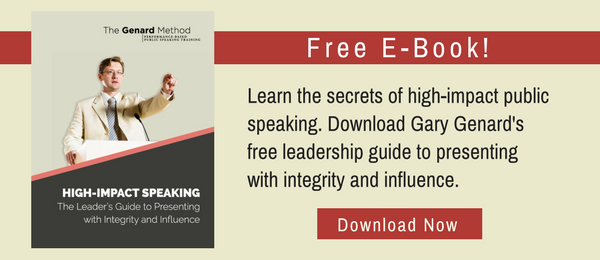
Want some fast advice on presenting more dynamically? Here's A Quick-Study Guide on How to Be an Effective Public Speaker.
How do you distill a vast topic down to a magic elixir that will produce instant results?
That's basically the task that I was faced with recently. At my company The Genard Method, we provide 1:1 executive coaching courses in communication skills, along with presentation coaching for upcoming appearances. (In addition to those individual coaching courses, we also offer on-site corporate training). Our two coaching products are very different in scope and direction. On this day, however, a new client had signed on for one service, but apparently wanted the other.
Based on what I had been told about this person's needs, I was ready to conduct some short-term presentation coaching. But instead I got the question: "What can you tell me in a nutshell that will help me be a better public speaker?"
Can you achieve credibility quickly with an audience while unlocking your natural talents? Absolutely! Get my free e-book, "12 Easy Ways to Achieve Presence and Charisma."
So I thought: "Can I boil down our Executive Speech Coaching course (a 10-hour program) into a few remarks for this client?" Of course not. But I did come up with an approach that I think can be tremendously helpful in terms of becoming a more in-the-moment speaker. Generally, my thoughts were on stage presence and how to speak more dynamically and memorably.
Call it 'A Quick-Study Guide on How to Be an Effective Public Speaker.'

Do You Create the Right Environment?
The key to being a truly successful public speaker is to get in the performance mindset, and stay there throughout your speech. Great public speaking is worlds apart from someone standing on stage and reading from a manuscript, a research paper, or PowerPoint slides. In other words, it's organic. You may not equate this with the last business or academic conference you attended. But a speaker's job is to take an audience on a journey, while engaging them—perhaps even exciting them—intellectually and emotionally.
Sure, you need strong platform skills to do this. But first you, as speaker, have to create the right environment. Audiences take away what they see and hear, and their responses don't emerge mysteriously from the ether: they will react in direct proportion to what you give them. If you have a tendency to depend upon your content alone to create the influence you're looking for, then you don't understand the public speaking dynamic.
Your role is to be as much of a performer as an actor is; and truly, it's the role of a lifetime. You have five key tools at your command to give a great performance: your eye contact (and facial expressions), voice, body language, using the stage itself for drama and effect, and connecting with the audience. If you read this blog, you know that I cover performance skills regularly and in depth, as in the links above. But that last area bears some more cyber-ink here.
How to Connect with Audiences for Stage Presence
Here too, your mind needs to be in the right place. You'll find this illustration in my book on overcoming speaking anxiety, Fearless Speaking:
 It's meant to indicate the narcissism that can be a major factor in stage fright. Though we may not generally be egotists, some of us place ourselves at the center of the speaking 'universe,' paying more attention to how we're feeling (and how we think we're coming across) than about who truly matters: the audience. They should be the ones represented by the sun in this picture.
It's meant to indicate the narcissism that can be a major factor in stage fright. Though we may not generally be egotists, some of us place ourselves at the center of the speaking 'universe,' paying more attention to how we're feeling (and how we think we're coming across) than about who truly matters: the audience. They should be the ones represented by the sun in this picture.
Once you understand that, you can give all of your focus and attention—as indeed you must—to a) giving listeners what you think they need, and b) paying close attention to whether they get it. As I said above, whether both of those outcomes take place depends directly on how much effort you put into the attempt.
Here's the good news about all of this: connecting with an audience is a simple process (though it's not always easy). It really requires just one thing: your willingness to be present for your listeners. Yes, you must have faith in your ability to talk on your subject . . . but isn't that why you are the one giving this speech? Anxious and defensive speakers over-prepare in the hope that 'nothing can go wrong' if they memorize every nook and cranny of their topic. But wouldn't you rather just share your knowledge and passion with people who are as interested in the topic as you are? Your audience is certainly hoping you do.
You should follow me on Twitter here.



